| Please access the following URL if you want to secure using SSL. All pages in the site will be secure pages. |
https://secure02.blue.shared-server.net/www.fish-food.co.jp/message english 11.2021.html |
Welcome to FISH FOOD TIMES
Nov. 2021 issue No.215


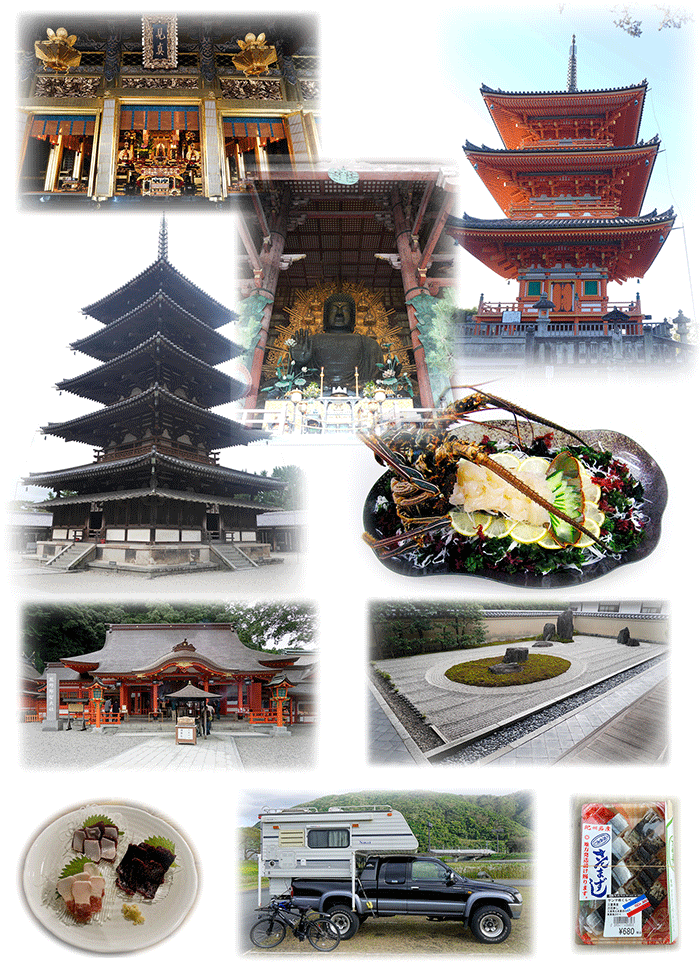
I wanted to eat spiny lobster, but ...
Traveling alone
The annual "Overseas Fish Circumstances" in November is a world that readers know, so we had to cancel this year as well. Therefore, I proposed to wife to visit Ise-Shima in Japan during the planned travel period in October, which was reserved in advance at the beginning of the year. However, the reply was an unexpected word, "Because the calligraphy promotion test is coming up at the beginning of November, please go alone."
In October, I was thinking of going to Ise-Shima to eat spiny lobster, which has been lifted from fishing bans in various parts of the country. However, when it comes to traveling alone, I used to assume two couples, but this time I decided to make it a little different. In the case of overseas, I've been alone in Asian countries where my wife doesn't want to go, but when it comes to domestic travel, I thought it wouldn't be fun to travel normally.
My wife doesn't have very strong legs. Therefore, there was a situation that behavior was restricted if there was no vehicle as a means of transportation at the destination. However, this time, I am the only author who is proud of his healthy legs, whose body age is in his 50s. And the conclusion I came up with was to load the unused Tru-cam on my car Hilux, and load an electric bicycle on the back to carry out "Cycle & Tru-cam" instead of "Cycle & Train".
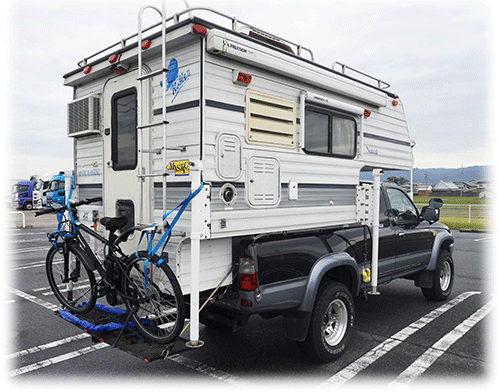
As shown in the image above, I decided to put the electric bicycle Panasonic Hurryer on the removable step that I made by electric welding. In the image below, I think some of you may feel that the camper is shifted backwards and may not be in front of you. The reason for this is that the Hilux is a type of 2-door extra cab equipped with an electric crane with a winch, so the width must be shifted backwards. An ordinary extra cab without a crane fits comfortably and in a well-balanced manner.
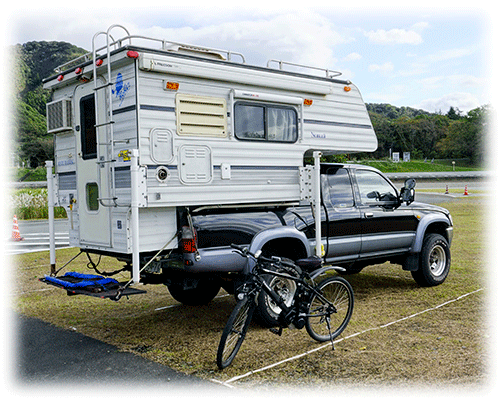
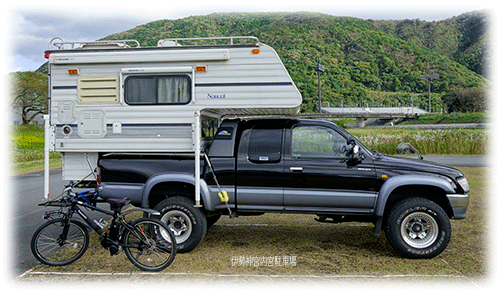
When acting at the destination of the trip, I used the electric bicycle off the step as shown in the image above. This method was really great when traveling, and I clearly felt that it was a much more rational method than renting a car. However, I hadn't used Tru-cam itself for a long time, so I had a lot of troubles. She strongly regrets that machinery that hasn't been maintained for a while is like saying, "I hate not using me!"
In December 2006, I went to Yamanashi prefecture by Hilux, bought a tiger can, and loaded it back in Fukuoka. This Tru-cam is an American-made SIX PAC, and was sold by a company called MYSTIC in Yamanashi Prefecture with a structural change to Japanese specifications. Actually, since I used this Tru-cam in October 2008, I left it without using it at all. Even though it was left unattended, it was parked in a well-ventilated and open covered garage for a long time as shown in the image below. Therefore, despite having been left unattended for a long time, there is no mold inside the car, and aging deterioration such as sealing and packing on the outer circumference is not so noticeable. It's in good shape, just by looking at it.

However, when I loaded the Tru-cam on the Hilux, it turned out that there were various problems, such as neither that nor this. The first problem this time was that the back camera for Tru-cam did not show the image. With such a huge body piled up, the length is longer due to the addition of steps, so the total length is about 5 m 50 cm even if it does not exceed 6 m, so it is dangerous and you can not move without a back camera. .. On this issue, I visited the company where the Home Car Doctor, who I have been familiar with for more than 20 years, is located, and had a new camera replaced on the day of departure. And I was able to leave at the scheduled time.
To Kyoto, Nara, Ise, Shima, Nanki, Kumano, Koyasan
The travel period was 7 nights and 8 days from October 16th (Sat) to October 23rd (Sat). I made a reservation in advance only for the Meimon Taiyo Ferry from Shin Moji Port to Osaka Nanko on the night of the 16th, and did not reserve anything else, including the return ferry. That's because the Hilux has simple accommodations, so I thought it would be possible depending on what happened. Certainly, I managed to do it, but it is a true feeling that "If I continue to live like this, I will make it die young ...".
I was supposed to go to Ise-Shima in the first place, but why did it expand to Kyoto, Nara, Ise, Shima, Nanki, Kumano, and Koyasan? This is because the author's concern has been "old architecture" these days, and I wanted to visit and learn about the temples and shrines in Nara, Kyoto.
My interest in old architecture is because, first of all, it took about a year to build the three-storied pagoda in the image below at Shohoji Temple, which is across the road from our office. Secondly, the house where our office is located is a building that was built and lived by the head of a palace carpenter who specializes in building temples and shrines, and the building is studded with the characteristics of temples and shrines everywhere, this is because it is a little different from general Japanese-style architecture. However, the 43-year-old building has been left unattended for almost 20 years, causing problems here and there due to deterioration over time. Therefore, I decided to use my hobby of do-it-yourself skills to repair these, but each time I was made to feel the depth of Japanese-style architecture and its technology.

| Shohoji temple three-storied pagoda |
The Shoboji three-storied pagoda in the above image was taken by the author in May this year. It seems that the interior was almost completed in July, but the announcement seems to have been delayed due to the new coronavirus. However, as the movement of people in the precincts has become fierce these days, I feel that the official release to the public, including the announcement to the media, is imminent. Was taken by the author in May of this year, and it seems that the interior was almost completed in July, but it seems that the announcement has been delayed due to the new coronavirus. However, as the movement of people in the precincts has become fierce these days, I feel that the official release to the public, including the announcement to the media, is imminent.
It looks like gold, and the Japanese cypress used as a material looks like it shines golden, but it looks like unpainted solid wood except for Kibana. According to the general manager of a palace carpenter specialist in Iwate prefecture, who happened to be able to talk about the process from design to construction, this golden color keep for about five years, but after that it gradually became black and became old at temples and shrines. It means that it will be that old-fashioned pale shade that you often see.
It will take more than a year to build, but before that, it will take two to three years to prepare all the building materials in Iwate Prefecture, and after that, the three-storied pagoda will be assembled locally. It is surprising that they will be assembled, checked to see if they are as designed, and after various fine adjustments, the three-storied pagoda will be dismantled and then transported to the designated location for actual construction.
In other words, being able to make such a trial once, dismantle it, and build it again means that almost no nails are used. It can be understood that this is a technology that can only be achieved by making full use of the technology of combining wood called "Tsugite", which is the real thrill of Japanese architecture.
By the way, I asked the person who seems to be the general manager who designed the building how much the construction cost would be. It is assumed that the person does not know the official amount, but in general, it is necessary to build a three-storied pagoda, including 100 million yen for one layer and 100 million yen for related construction costs such as foundations. He told me that it is said that about 400 million yen is needed.
So far, there are only two three-storied pagoda in Kyushu. Kiyomizudera Temple, located in Setaka Town, Miyama City, Fukuoka Prefecture, has a three-storied pagoda that was completed in 1836 over a period of about 14 years. This pagoda Buddhist consecration ceremony was held on November 23, 1844, with all the monks in the Yanagikawa clan, and is said to have used a total cost of 250 gold coins. This is the oldest ancient building in Kyushu and became an important cultural property of Fukuoka Prefecture in 1957. The other is located at the site of Kokubunji Temple in Miyako-cho, Miyako-gun, Fukuoka Prefecture, and has a three-storied pagoda that was built in the Nara period, then burned down and rebuilt in 1887, and was restored in 1987. However, it seems that there is no temple itself and it is the site of Kokubunji, and it seems that only the three-storied pagoda exists there, and the five-storied pagoda is excluded from the calculation, and the Syoboji temple three-storied pagoda is considered to be the third in Kyushu after this. Would be good.
Originally, the do-it-yourselfer is a hobby and does various things by myself. The time when the Syoboji temple three-storied pagoda began to be built was about the same time as the corona disaster, and the work of the original fishery consultant was reduced and I was free, so I made use of my time to make an open-air bath of granite. It took about a year to complete this work in March this year. However,my work time continued after that, and I decided to spend my spare time repairing the 43-year-old purlin. This is quite tough and I haven't reached the point where I can see the end yet, but as I worked on various things, I began to feel the depth of the work of the palace carpenter.
For example, Futanoki. The eaves of the venerable temples and shrines are basically Futanoki, and of course the three-storied pagoda of Shohoji is also the same. The main location of the company building, but not all, is Futanoki, as shown in the image below.
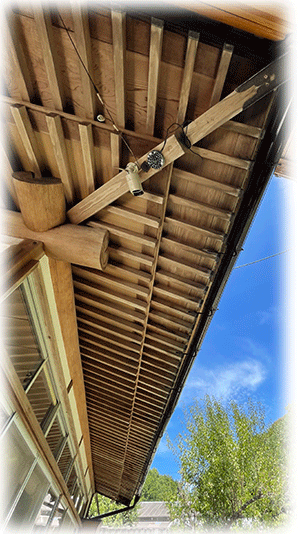
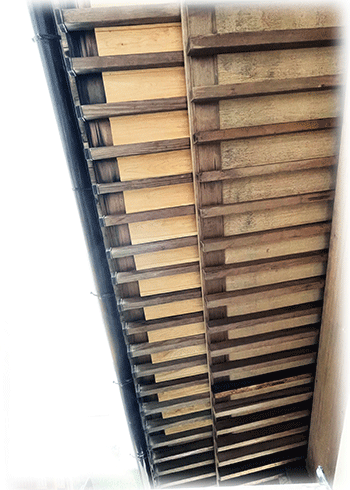
| Futanoki at the top of Engawa | Futanoki at the entrance (currently in the process of restoration) |
There are many other things, but I won't go into that any further here. This time, I wanted to visit not only Ise-Shima but also Kyoto and Nara, visit Horyuji Temple, which is also called the museum of ancient architecture that is the basis of Japanese architecture, and learn various things from the real thing.
| First of all, I would like to say a few words to our readers. What I can say about this month's issue is that due to the series of miscalculations in this trip, the content of this article, which is not like FISH FOOD TIMES dealing with fish, will continue. If you are only interested in fish, it may be a waste of time, so we recommend that you stop reading after that. However, if you are interested in my random travel notes, please continue reading. |
Kyoto
I managed to board the ferry departing from Shin-Moji Port at 17:00 on Saturday, October 16th, and landed at Osaka Nanko after 5:30 the next morning. The ferry room is a driver's room exclusively for truck drivers, and the "Ferry Kyoto" to go is an old-fashioned type with bunk beds, a light-shielding roll screen that can be raised and lowered, and a TV. There is. It's private to some extent, but imagine it's at the level of a capsule hotel.
However, the "Ferry Kitakyushu" that boarded the ship on the way back was the latest model that had just entered service in 2020. Even in the same driver's room, it was a private room type that was locked, and it was equipped with a desk and chair as well as a TV, and it was like a single type narrow version of a hotel without a bathroom. The Hilux is more than 5m and less than 6m, so it costs 35,200 yen one way, but the 20% discount is applied on the way back to 28,160 yen, and the total round trip is 63,360 yen, so the one way is 31,680 yen. Even if it is only one way, it can be calculated that it is much cheaper if you think about the cost of staying at a hotel by self-propelling on the Hilux, paying the fuel fee and the highway fee. Not only is it cheap, but sleeping soundly in a single bed and arriving in Osaka when you wake up is a comfortable way to travel between Kyushu and Kansai by car without the tiredness of driving.
On this day, I planned to go straight to Kyoto and visit as many temples and shrines as possible. Therefore, I decided to leave the Hilux loaded with Tru-cam somewhere, drop off the electric bicycle and act in the town of Kyoto, but I have not decided where to deposit it yet. I was doing some preliminary research online and in books, so when I called RV Park Kyoto Chuo in Ukyo-ku, Kyoto, he replied that there was a vacancy.
I arrived after 9 o'clock and went through the procedure for one night until the next day. Check-in is from 13:00 and check-out is until 12:00. The basic charge is 3,300 yen per camper, and the time extension is 300 yen per hour. However, including the early check-in at 9:30, the power supply fee of 1,000 yen, and the bath fee of 200 yen, the total amount was 5,280 yen, which I think is a little expensive for a vandwelling.
However, Hilux campers cannot park in the street parking, which is originally made for ordinary passenger cars in both length and width. If you can park overnight, stay overnight, and take a bath, you can calculate that the cost performance is still high.
I decided to take the electric bicycle Hurryer off the step and move around the town of Kyoto. However, a problem was already discovered in Tru-cam, and I had to deal with it. That's because the newly purchased 105A deep cycle battery didn't work. I also loaded an engine generator called HONDA 16i in Tru-can, but when I started this engine and connected it to the plug, the engine stopped. Actually, this generator only supports up to 80Ah, and if you connect it to a camper equipped with a 105Ah battery, the engine will automatically stop due to overfunction.
As a result of doing so, the converter that converts 12V to 100V seems to have broken, and the refrigerator only worked when it was connected to a 100V AC power supply.
For this reason, the water from the water tank could not be taken into the faucet, and it was necessary to purchase spare cylinders for the gas stove and rice for camping that were brought for future trips. For that purpose, I first headed to Ishii Sports in Yodobashi Camera Kyoto near Kyoto Station.
Hurryer assists the pedals powerfully, so I was able to speed up quickly and reaffirmed that it was a comfortable means of transportation. It took about 5km and 30 minutes to reach Yodobashi Camera, and I was able to travel a distance of about 5km on my iPhone in about 15 minutes while following the navigation of Google map. And I had to spend 4,163 yen on the necessary materials.
After that, I was finally able to go sightseeing in Kyoto, so I decided to head to Nishi Honganji Temple first. This is because the denomination of the family is the Nishi Honganji sect, so I thought I would visit it first. It took about 2 km from Kyoto Station to Nishi Honganji Temple and it took about 15 minutes to get on the Panasonic Hurryer.
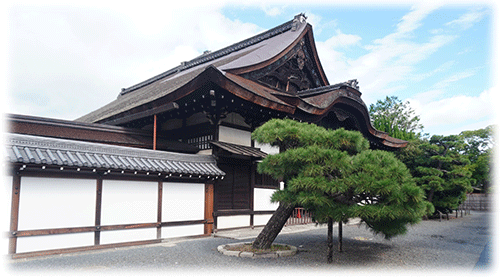
This building is a Shoin called Ryukoden, which is located outside the main character, Goeidou, in Nishi Honganji, so I couldn't enter it. However, for the purpose of this time, I was able to take a closer look at this place with few tourists.
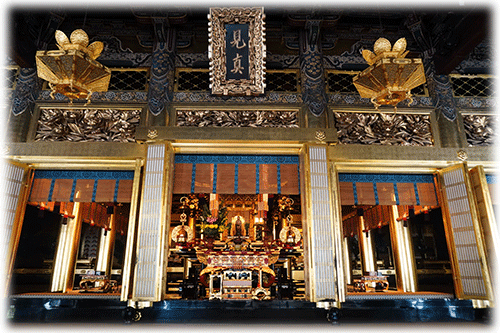
And the worship at Goeido. I went and pray at a temple while being afraid of the gorgeous and spectacular atmosphere.
The next place I visited was Daitokuji Temple. Daitokuji was one of the temples I visited in Kyoto because it was mentioned in the book "This is the highlight! Introduction to ancient architecture" that I bought to learn about ancient architecture. The distance to Daitokuji was about 6 km and I think it took more than 40 minutes, but unfortunately it was raining and I had to wear the kappa I had prepared.
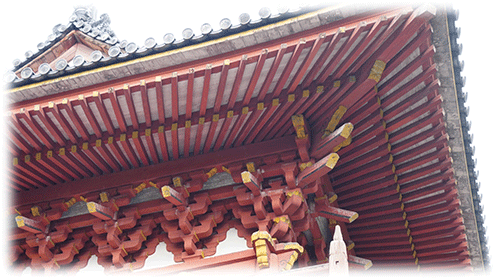
The Daitokuji gate was irimoya style, and the tiled roof was a large red-painted gate with a splendid Futanoki.
There are more than 20 temples in the precincts, among them, Ryugen-in is the oldest and central. Famous for this temple is the Karesansui Gardens.
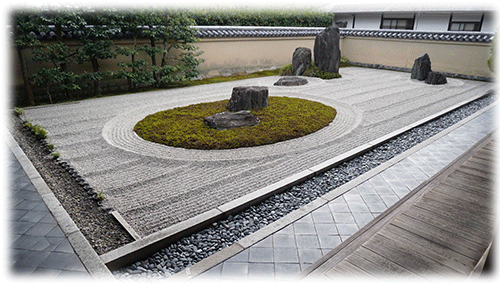
Speaking of Karesansui, the most famous one may be Ryoanji Temple, but I was able to understand that even though Karesansui and Ryoanji Temple are similar, I visited Ryoanji Temple via Kinkakuji Temple and understood that they are different.

This is the Hojo Garden (stone garden) of Ryoanji Temple, which is one size larger, the space is conspicuous, and the ball gravel is smaller than Ryugen-in Temple, giving it a more delicate feel. Ryugen-in has two other small Karesansui gardens, and I felt that the Karesansui garden of Ryogen-in was thick and varied due to the slightly larger ball gravel.
By the way, the image below is a small Karesansui-style tsubo-niwa beside the open-air bath I made from last year to this year.
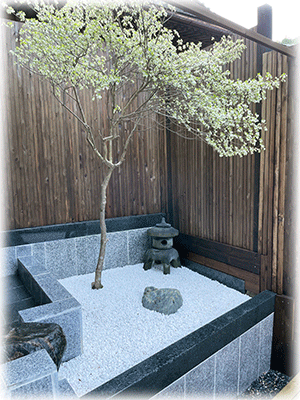
This Tsubo-niwa has one Enkianthus perulatus, also known as Mantenboshi, which blooms bell-shaped white flowers in spring and leaves turn red from autumn to winter. Therefore, you can feel the season in the open-air bath.
After Ryugen-in, I headed to Kinkakuji Temple. From Daitokuji Sanmon, I arrived at Kinkakuji in about 10 minutes in less than 2 km while going up and down the curved road. When I arrived at Kinkakuji, the situation changed completely due to the large number of tourists. In particular, groups of school trip students are conspicuous, and the number of general tour tourists is increasing, making it impossible to visit temples as quietly as before.
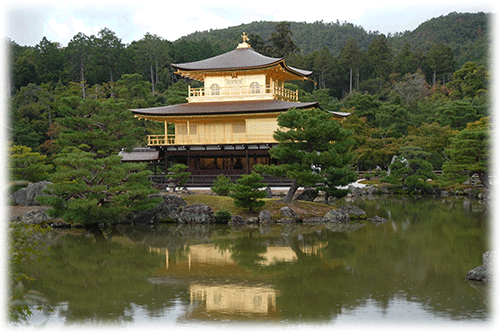
It was so noisy that I bought a souvenir of Wasanbon sweets, which is sold only at Kinkakuji Temple, and decided to leave early and headed to the next Ryoanji Temple.
Ryoanji Temple is another curved straight road, and a little less than 1.5 km arrived in less than 10 minutes. The arrival time at Ryoanji Temple was already around 17:00, and it was just before the gate closed. For this reason, there were no group tourists, and only a small number of tourists were relieved. I have already mentioned Karesansui, so I will omit the explanation, but the other thing I was interested in at Ryoanji was the Tsukubai in the image below.
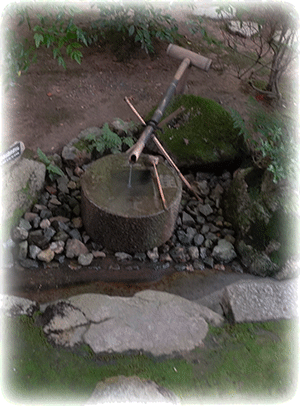
Tsukubai, which is said to have been donated by Mito Komon, sees the square part where water falls and collects as a letter of the mouth. It is engraved with "I only know what is enough".

The reason why I was interested in Tsukubai is that I have the next creative goal as a tsukubai.
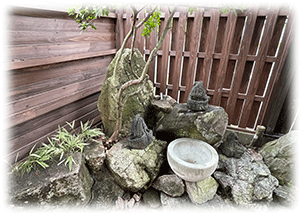
As shown in the image above, the stone mill has been placed at the corner of the board wall on the road side of the main house. However, I haven't made any progress beyond that, and I'd like to make it a shishiodoshi style and enjoy the sound, but it's completely unknown when I can start.
The first day of Kyoto ended at Ryoanji Temple and we decided to return to RV Park Kyoto Central. We stopped at the supermarket Hankyu Oasis on the way for about 5.5km, and arrived in about 30 minutes while purchasing apples, oranges, yogurt, and so on. The distance I traveled on the electric bicycle on that day was about 22 km, and the process and content were quite convincing for me, so I was enthusiastic to eat delicious fish as a reward for myself at night.
After taking a bath before 19:00 and refreshing, I walked to a nearby place. And when I tried to enter the Japanese style shop, I was told that the order would be stopped at 19:30. The same was true at another store, and the next store was no good. After all, there was no store that could be entered for meals after 19:00. This night, I bought a beer and a side dish at a nearby convenience store with a feeling of crying and crying, and had a lonely dinner at the table in Tru-cam.
With the exception of Nara the next day, this situation was similar in Tsu City two days later, and then in Shima, which was a huge miscalculation.
From Kyoto to Nara
On the second day, I decided to stay in Kyoto until noon and head for the next Nara. First thing in the morning, I headed to Kiyomizu-dera, which is 5.5 km from the center of RV Park Kyoto. It took about 40 minutes by electric bicycle to reach Kiyomizu-dera, but the mountain opened at 8:30, and the author who arrived at 8:35 seems to have been the earliest visitor of the day.
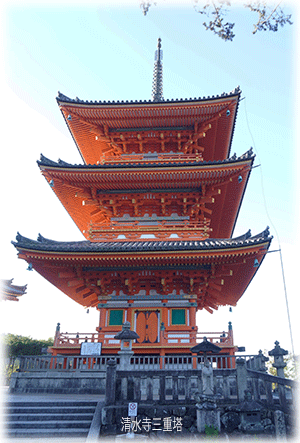
The three-storied pagoda that was shining in the morning sun was as wide as Futanoki's wings spread, and the height was 31m, which is one of the largest three-storied pagoda in Japan, and the whole was painted in vermilion. I felt that the atmosphere was quite different from Syoboji's three-storied pagoda. There is a distance like the image below from the Hiwadabuki main hall where the stage of Kiyomizu is located, and the atmosphere is completely different, so I felt that it was interesting to contrast.
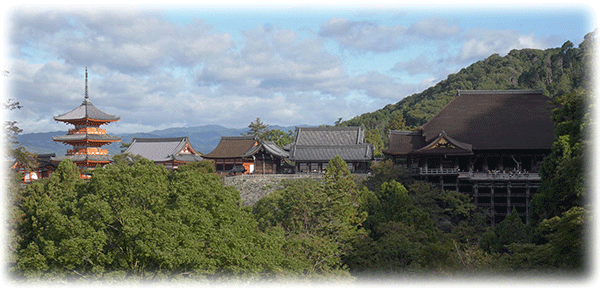
There was information that the water flowing from Otowa Waterfall, which was named after Kiyomizu-dera, cannot be drunk with a cassotte due to the influence of the new coronavirus. However, since it was early in the morning and there was nobody, I made a donation and finished drinking water with a cassotte without permission, and when I started heading for the exit, the door of a place like a management office opened rattlingly and a person appeared, I was sick. In this way, at Kiyomizu-dera, I enjoyed a quiet walk with few tourists for about an hour, and returned to RV Park Kyoto Central in about 40 minutes, the same time as when I came as it was.
I left for Nara after 11 o'clock. On this day, I was able to make a reservation for a place called RV Park Yakushi no Sato without any problems despite the day. However, when I went to the place as guided by the navigation system, there was only gravel in a field like a field where four baseball grounds could be secured, and there was nothing like that. I thought this was a big mistake, so I went to another RV park I searched on the net, and this time it was unreasonably narrow and dirty, and I decided that this was even worse. Eventually, I returned to the originally planned RV Park Yakushi no Sato and called. Then the owner of the phone told me that he had a place for the number 4 and put the 3,000 yen charge in the blue mailbox and asked me to use it without permission.

When I went to the 4th place, there was a power supply, a sink and a faucet, and it looked like the image above borrowed from the net, but the rattan chair was unusable because it was broken and it felt like it was wild and all-you-can-eat. It seems that there was a simple toilet in a remote place, but I didn't dare to use it. I finished standing in the field just behind the parking space for urine, and went to another place the next day for stool. I didn't even meet the manager of the RV park until the next morning.
In Nara, Horyuji Temple, then Todaiji Temple, and Toshodaiji Temple were my priorities for visiting. However, there was Toshodaiji Temple very close to RV Park Yakushi no Sato, so I decided to go to Toshodaiji Temple on the afternoon of the first day in Nara. It was a short distance of about 2 km, but time passed while I was making various preparations, and I arrived at Toshodaiji Temple at around 16:30. There, I was asked, "The gate closes at 17:00, can you enter?" He entered the temple thinking that 30 minutes would be fine, but he left the temple immediately.
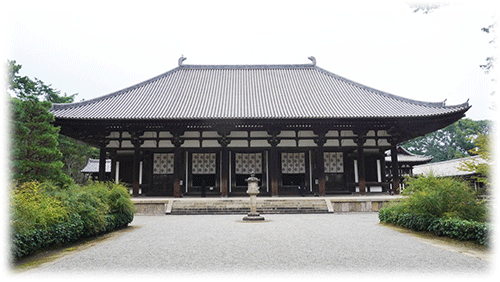
The image above is a national treasure, Kondo, which is said to have been built in the latter half of the 8th century.

I couldn't afford to take a leisurely tour of various things, but I felt that Futanoki at Toshodaiji Kondo was quite different from the ones at the temples in Kyoto, as shown in the image above. He left Toshodaiji Temple without a leisurely tour, but found that Yakushiji Temple was in close proximity. I knew I couldn't put it in it, but I went to Yakushiji by electric bicycle and confirmed only the appearance of Yakushiji as shown in the image below.

Nara night harvest
I made a painful mistake the night before in Kyoto, so I decided not to make the same mistake again this day. So after 17:00, I started looking for a suitable place for dinner as early as possible. I took an electric bicycle to a busy place in Nara City and started looking for a suitable store. Then, I found an interesting shop, so I decided to go in. That was the "Daiki Fisheries Town Minato Nara Store" in the image below.

As shown in the image, there was a fish counter of Daiki Fisheries, and next to it, there was a restaurant selling fish side dishes called "Machi no Minato Shokudo". It may be a problem for me to enter the cafeteria without looking at the fish counter, but the aftereffects of the night before were trailing.
It's a self-service system where you take your favorite side dish, pay for it, and bring it to the table yourself, but it's really cheap.

A medium bottle of beer usually costs 500 yen, but assorted sashimi costs 300 yen, pickled horse mackerel nanban is 100 yen, and boiled tuna costs 100 yen, for a total of 1,045 yen. The seasoning was delicious, and the two male employees were very friendly. In the end, I added two dishes of 100-yen side dish and two bottles of beer.
And, really interestingly, something that could only be called a strange thing happened. A trio of men came right behind the table where I was sitting and started a business meeting without eating. I couldn't hear the content of the story, but I could only hear that the oldest and most prominent person was constantly repeating "700 yen, 700 yen ...".
When one of the two employees called out to the bossy person, "Chairman ...!", He speculated that he was probably the chairman of Daiki Fisheries. Then, after the meeting of the three people was over and he disappeared from there, when I asked an elderly employee the truth of the guess, he was definitely Chairman Yasunobu Saeki himself. I described him as arrogant, but that doesn't mean he's arrogant, he's obviously the oldest, so he just looked awesome.
In the September issue of FISH FOOD TIMES, the author questioned the direction of Toshin Sea Foods. And as far as I can see the direction of Daiki Fisheries, "Minato Nara store in town", I felt that there was something close to the direction I thought. In the Kanto region, I feel that I can agree with the direction of Kakujoe fish, but in the Kansai region, when I saw the Daiki Fisheries Nara store this time, I thought that there was something I could agree with. This is not this month's issue, but I would like to set a new theme on another occasion and mention it in depth. The distance traveled by bicycle on that day was about 20 km.
To Tsu City via Horyuji Temple and Todaiji Temple
On the 19th, which is the 4th day from the departure, I will visit one of the main destinations of this trip in Nara. I left RV Park Yakushi no Sato before 8 am and traveled about 10 km to Horyuji Temple by electric bicycle for about an hour. When I moved around, I found that Nara is a city that is friendly to bicycles, as it has a well-maintained cycling road, and although it also has a part that doubles as a car, it has been reserved for bicycles for a long time. However, for the author, traveling a distance of more than 10 km from the beginning of the morning by bicycle was quite a burden, and although there was a feeling of exhilaration, there was a response that it worked.

I arrived at Horyuji Temple, which I wanted to visit most on this trip, around 9 o'clock. Horyuji Temple is also called the "Museum of Japanese Architecture History", and the Kondo, Five-storied Pagoda, Yume dono, etc. are the oldest wooden buildings in the world, and are the best teaching materials for learning about ancient architecture.
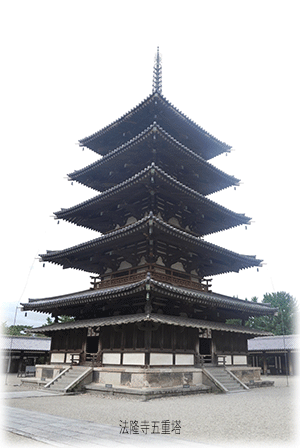

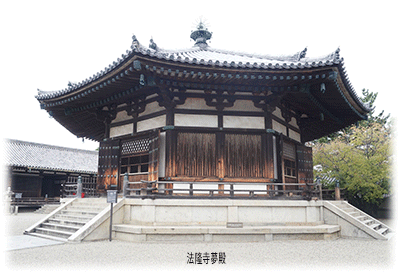
The above three buildings are national treasures that represent Horyuji Temple. The world's oldest wooden building, built in 607 AD, remains in such a solid state even after more than 1400 years. On the other hand, our building is only 43 years old, but it is showing signs of deterioration over time.

There is a record in the Nihon Shoki that Horyuji Temple disappeared in 670 due to a fire. There seems to have been a lot of academic controversy about this, but as a result of taking a picture of the wood used for the attic with a high-precision digital camera of 11 million pixels and analyzing it, it was found that it was rebuilt by the latter half of the 7th century after the fire. It seems to be the current dogma. It is calculated that the number of years since construction will be shortened by about 100 years, but it is still amazing because the wooden construction still remains after 1300 years.
I stayed at Horyuji Temple for about 2 hours until around 11 o'clock, and I was able to visit every corner with the thought that I wouldn't know when I could come again, and I was satisfied with myself. This is not the first time I have visited Horyuji Temple in my life, and I think it is my second visit, but I have little memory of it before. It was reminded that when humans come into contact with a certain scene, their impressions and memories are quite different depending on what they are interested in and what part they are interested in.
With a pleasant feeling of satisfaction, I left for the next Todaiji Temple. On this day, I had already traveled 10km by bicycle from my accommodation to the southwestern direction where Horyuji Temple is located, but this time I have to go back to the northeastern direction of the departure point and travel about 18km past. .. There was Kofukuji Temple, which was introduced in an old architecture book, on the route of Todaiji Temple in the direction of movement, so I decided to stop by here as well.
Kofukuji Temple is located in Kasuga Park, which is adjacent to Kasuga Taisha Shrine, and school trip students and general tour groups were walking around. There was also a famous deer in Nara sightseeing, and it was exactly the place of the image of Nara sightseeing. I have a strong desire to avoid noisy places because there are too many people like this, so I visited only the five-storied pagoda and headed toward Todaiji Temple. For this reason, I felt too strong to leave the crowd and forgot to take a picture at Kofukuji Temple.
The image below is Todaiji Temple.
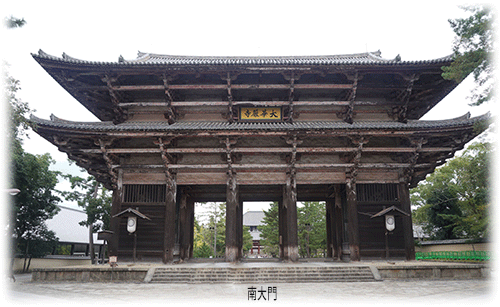
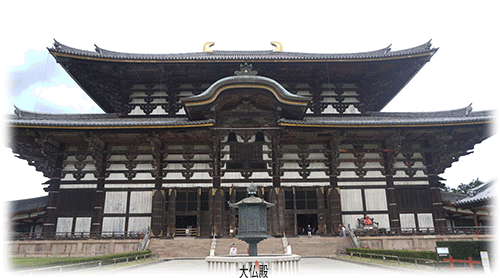
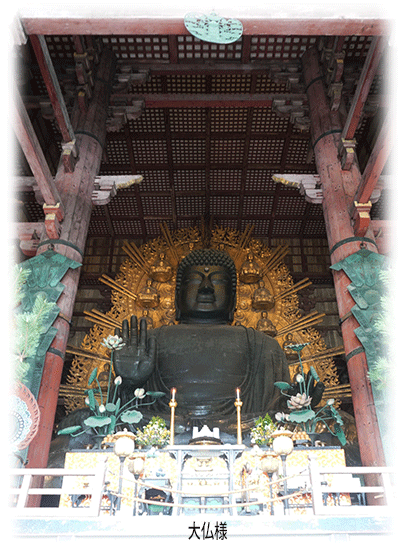
I don't think it makes much sense to explain to the readers here using the terminology of ancient architecture. For this reason, I would like to mention as an impression that everything at Todaiji is extraordinarily large for a wooden building.
After leaving Todaiji Temple, I returned to RV Park Yakushi no Sato for about 40 minutes, 8 km away. After returning to the camper, my job is to find an inn tonight. I had decided to visit Ise Jingu in Mie Prefecture the next day, but I couldn't find a suitable RV park near it. Therefore, there was an RV park in Tsu City, Mie Prefecture that seemed to be easy to use, although it would be a little detour, so I called. Then I decided to stay there on this day because there was a vacancy.
It was about 100km from Nara City to Tsu City, but when I arrived at the target "RV Park Tsu" in about two and a half hours, it was already past 18:00 and the place was already pitch black. Below is an image borrowed from the Car Travel website. It was a gravel site like RV Park Yakushi no Sato the day before, but the ground was well leveled, the size of the gravel was small, and the parking space was neatly divided. The size was wide and long enough to accommodate more than 10 campers, and it was spacious and easy to use despite being adjacent to a residential area.
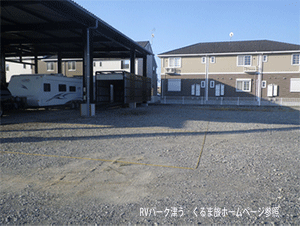
This was also a method of putting a charge in the mailbox, but it was cheap at 2,000 yen with a power supply and 1,500 yen without a power supply. What's more, you can use the water sink, the toilet with a washlet, and even the bath as much as you want. I was surprised at this overwhelming cost performance.
t was already around 19:00 on that day, so I decided to avoid wasting legs like the night in Kyoto and have a lonely dinner with beer and snacks in the camper car. It seems that I was the only guest on that day, and it was the best place to get rid of the tiredness of moving around in Nara without being noisy. The bicycle mileage on that day was about 40km.
Ise,Shima
On the morning of the 20th, I had a really good night's sleep with a camper. From around 7 o'clock, I took a morning bath, washed my hair, refreshed various things, and prepared for departure. I have been greeting you. They were like the owners of this RV park. I thanked them for being a great and cost-effective facility. When I asked him how to park his camper at Ise Jingu, he explained in detail the information he had. On top of that, it was a great help for me to provide various information about the Shima region where I plan to stay on that day. I paid 2,000 yen there this time, and I'm sorry to say that I was thankful.
After 9 o'clock, I left "RV Park Tsu". I arrived at Ise Jingu at a distance of about 60 km over an hour and a half. As I received the information, I entered Naiku B5 of the Ise Municipal Parking Lot and parked at the back according to the advice. There was no car around me, and I was able to freely raise and lower the bicycle without any hesitation.
I parked near the Naiku, but decided to visit from the Geku according to the principle of visiting Ise, and headed for Geku by bicycle. I arrived at Geku in about 20 minutes for about 4 km. Naiku and Geku are too long to travel on foot, so most people use cars or buses, but I did there and back by bicycle.
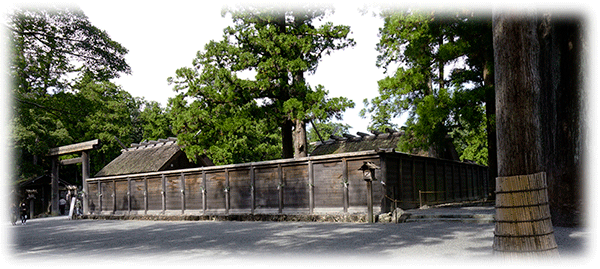

The image is Geku on the top and Naiku on the bottom, and this is the limit because the main shrine inside the wall is prohibited from shooting. The Shinmei-zukuri shrine is very different from Horyuji Temple, which is 1400 years old, and the shrine is rebuilt every 20 years. Most recently, it was built in 2013 and is a new building that is only eight years old. Not only the shrine building but also the torii gates, bridges, wooden fences, costumes, etc. can be rebuilt, and tens of billions of yen will be invested to make new ones.
Shikinen sengu is performed because it is made of Excavation pillars that pierce the ground with white cypress trees. Since there is no cornerstone, it is exposed to wind and rain and easily deteriorates, so it is remade every 20 years. Originally it should have been made of Japanese cypress, but in 2013 Shikinen sengu did not have enough cypress of the appropriate size, and the next cypress (Asunaro) was used in some parts. I was convinced that it should be the case, and it was really impressive that only cypress wood was used everywhere in the precincts, such as cypress, cypress, and cypress. It was a fierce contrast to see Horyuji Temple, which was 1400 years old the day before, and Ise Jingu, which was only 8 years old on that day.
After going from Geku to Naiku, I decided to have lunch with Ise udon.
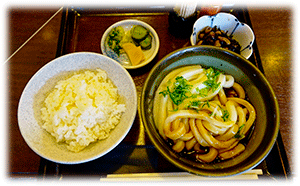
This is what we now call "bukkake udon", and there is almost no soup, and it is eaten with black and thick soup. It's not as salty as it looks, the thick noodles are soft, and I felt that it was a good taste for the author who is accustomed to eating soft Hakata udon that is not as hard as Sanuki udon.
This store was in Okage Yokocho. As of October 20th (Wednesday), the street was regaining the following bustle in the absence of foreigners.
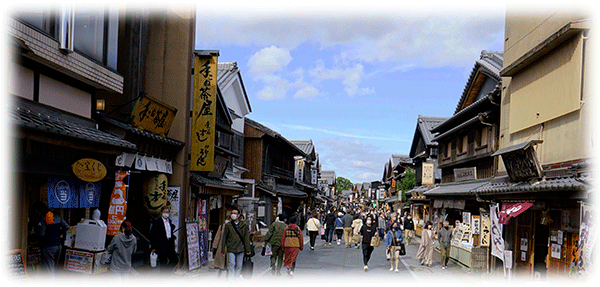
I also bought Oisemairi souvenirs on this street, but there was one interesting shop on that street, so I would like to introduce it to readers.

It is a store specializing in dried fish, and the storefront is decorated with dried sharks that are not pandas, and various other dried fish are displayed as decorations rather than for sale. .. And what was interesting was that a man was baking dried fish in the middle of the store, and there was a big pipe on it, and a blower was blowing the wind toward the road. It is a mechanism to attract customers with the good smell of grilled dried fish, just as it makes you smell the eel kabayaki and makes you appetite. Then, when the customer tries to look inside, the person in charge of grilling the dried fish at the store immediately offers the freshly baked dried product as a tasting. It was a business method full of interesting sizzle that customers who were caught by the smell and tasting went shopping. Why don't you use it as a hint when selling dried fish?
I left Naiku before 15:00, but then I'm looking for an inn tonight. On this day, I arrived at the accommodation early and was enthusiastic about the spiny lobster, which was supposed to be lifted from October, in a high-class place. However, due to the limitation of Hilux Tru-cam, no suitable place can be found. The place to look for was getting farther away from Ise City, and the final decision was the Shima Auto Campsite, which is about 45 km away. This place is in a place where I can't expect the existence of the store I'm hoping for, so after deciding that it was the only place in the end, I decided to give up the purpose of eating spiny lobster in the Ise Shima region.
On this day as well, I ate beer and side dishes alone in the camper at night. The bicycle mileage on that day was about 8km on a round trip between Geku and Naiku.
Kumano Nachi Taisha Shrine, and Taiji Town of Whales
The Shima Auto Campground has a gate that prevents you from going outside at night, and opens only at 8 o'clock in the morning. So on the morning of the 21st, I prepared for departure by 8 o'clock and left the campsite immediately after 8 o'clock. This is because I decided to head from Mie prefecture to Wakayama prefecture on that day and first visit Kumano Nachi Taisha Shrine, which is about 200 km away from there.
I used the Kisei Expressway for the first time on this trip. Most of them were free-passage sections, and although the high-speed tolls did not cost a lot of money, most of them were one-lane two-way traffic, and it didn't feel like a general highway. I moved around with a break and lunch on the way, so I arrived at Kumano Nachi Taisha around 13:00.
The lunch I bought at SA on the way is "Saury Sushi" in the image below. It is a Kishu specialty, and I think some readers may wonder why saury is a Kishu specialty. A long time ago, more than 20 years ago, when I went to a supermarket in Kansai for a fishery consultant job, I was wondering at the beginning that there were a lot of saury products such as the opening of saury in the fish department.
When I looked it up, the reason why saury is actively eaten in Wakayama and other areas in the Kansai region is that the southern limit of migratory saury from the northern sea is off the Kii Peninsula, and in the past many saury were caught. .. For this reason, saury was sent to Osaka and Kyoto as one of the representative fishes of the Nanki region, and it seems that it became established.
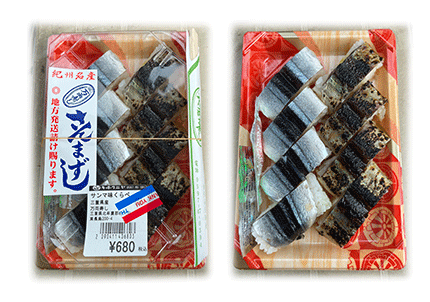
I finally arrived at Kumano Nachi Taisha around 13:00 while climbing the mountain road on the way. When I parked the Hilux in the free parking lot at the back and headed for the entrance to the approach, a long staircase with 467 steps to the location of the shrine was waiting. This staircase is meant to be climbed without haste, so I slowly climbed it over time.
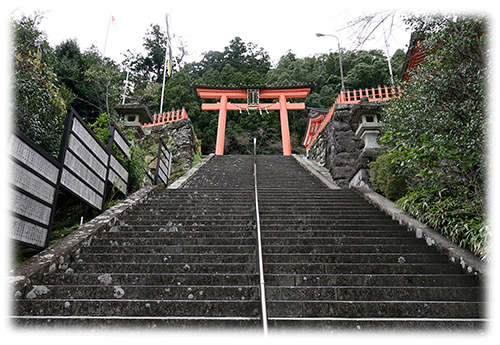
The main shrine of Kumano Taisha appeared after reaching the long stairs. The main shrine is a special one called Kumano-zukuri, which is a Kirituma-zukuri Tumairi with eaves on the front and rims on all sides.
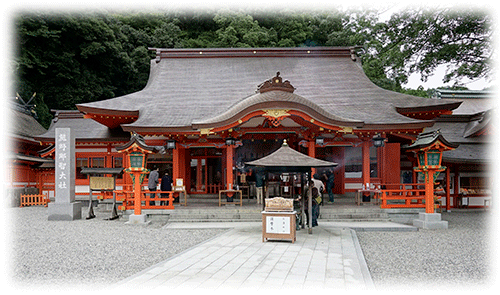
After visiting, I started going down the stairs, but I decided to stop by because there was a store I was interested in on the way up.
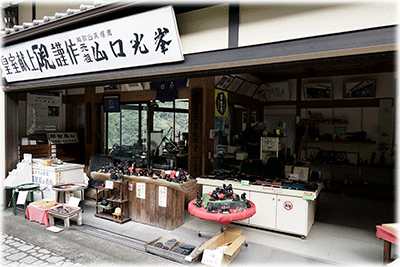
The shop called Yamaguchi Kohodo in this image is a shop that mainly makes inkstones using Nachi Kuroishi as a raw material, and it seems to be a venerable shop that also presents inkstones to the imperial family. The reason I was curious about this store was that wife didn't accompany on this trip because was preparing for a calligraphy promotion exam and remembered that. I came up with the idea that the inkstone of Nachi Kuroishi would be a useful souvenir for the calligraphy that wife is studying hard.
Talking to the shop owner, the price is about twice as different between machine carving and hand carving. When it comes to buying hand-carved items, it is a selling price that requires mental preparation. However, I decided to buy a hand-carved car so that I wouldn't regret it later. And when I consulted with the shop owner, he introduced me to the best recommended item in this shop.
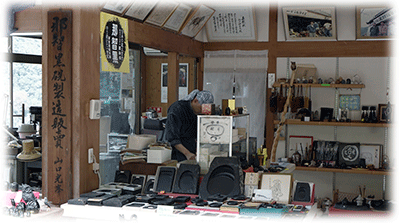
The shop owner explained that machine carving and hand carving are different, and I was advised to touch them with my fingers and rub the ink. When I actually rubbed the ink, it said that the surface was really smooth and that it hardly decreased even after long use. The owner's inscription was engraved on the back of the inkstone, and I felt that it was expensive to buy the inkstone for tens of thousands of yen, but as a memory of my trip, I made the most expensive purchase on this trip.
After this, I went up the back road again to see Nachi Falls and see the three-storied pagoda. However, the three-storied pagoda was the same as a concrete building instead of a wooden one. It was a tour tower that did not contain the "Shinbashira" that was supposed to be the center of it. It was a fake that resembled a three-storied pagoda, and I was disappointed with this and decided to aim for tonight's accommodation after 15:00.
The accommodation on that day was "TEMPLE CAMP Daitai-ji" in Nachikatsuura Town, which I had reserved when I took a break at SA on the highway. It should arrive within 30 minutes from Kumano Nachi Taisha Shrine, so I decided to stop by the Whale Museum in Taiji Town on the way.

This is the appearance of the "Taichi Municipal Whale Museum". Inside, you will find a huge model of a whale and various whale-related materials as shown below.
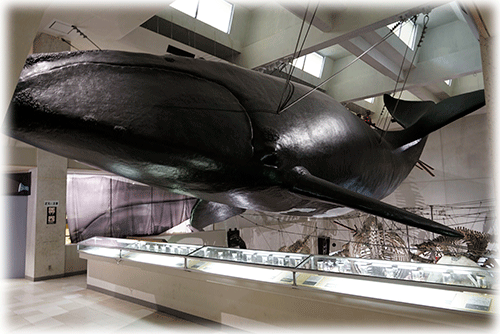
In the materials, the geographical environment where Taiji Town is located and the traditional eating habits were also exhibited. They were described not only for whales but also for dolphin fishing, which has many international criticisms.
FISH FOOD TIMES dealt with minke whales as the theme in the April 2016 issue No.148. I wrote that I visited the museum "Shima no yakata" in Ikitsuki-cho, Hirado City, Nagasaki Prefecture, where a similar whale museum is located. The author described the idea of the existence of whales and their position as follows.
| a long time ago is Western countries that had killed only to whale to take the whale oil, this time the "kill the whales feel sorry" in the absurd logic that to prohibit the Japanese whaling in the emotion theory that leap, I can not follow very. These leap logical is not going to also continue to pushed through forever. As Mr. Komatsu have been described, when the world eventually come looming food crisis that can not be solved by only terrestrial organisms, argued their legitimacy in a completely different logic of expansion, food of the human race seems to be or not to become trapped forced so the whales as a source. But I do not know when to become of it at that time, think that Japan must avoid likes to promote itself as the place where the historic "food culture of whale" for the occasion. |
The author's wish for the revival of commercial whaling, which I wrote in this way, was realized when Japan withdrew from the IWC (International Whaling Commission) in 2019. After that, as for whale meat, it is rare that raw whale meat arrives at the fish counter, and I feel that there is no big change from before. Even if you want to eat a whale, the environment where you can eat it immediately is not yet restored.
I was also looking forward to eating whale food that day, so I asked a person who seems to be a museum staff member to tell me the appropriate store for that. However, the answer was once again the cold and disappointing word that it was impossible to expect it in the current environment. Depressed that the whale was no good, I went to a store called Fishermen Association Supermarket to get a meal tonight. When I was wandering around the store with a shopping cart, the uncle at the meat department was chasing me with him eyes, as if I was a stranger. I asked the person, "It's not about meat, but do you know a store that feeds whales?" Then, after all, the answer was as expected, "This time ... it's difficult ...". I gave up completely and put beer etc. in the basket. Then, a person from the meat department chased me and said, "There is only one store where you don't have to worry about time, but would you like to go?" I answered, of course, please.
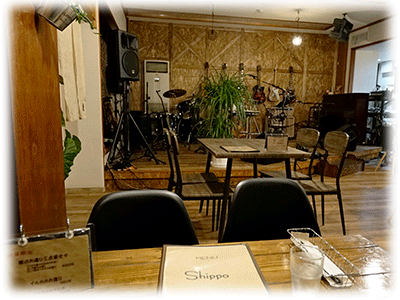
The store I was taught to enter was a cafe called SIPPO, and the store was equipped with a live performance stage, which made it look fashionable. The image below shows the whale dish that was ordered and brought to us.
| Sippo whale dishes | |
 |
 |
| Assortment of 3 whale sashimi 4,000 yen | Whale bone stripping 600 yen |
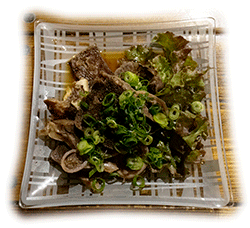 |
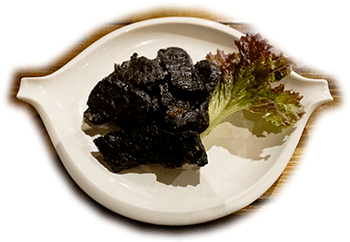 |
| Whale udemono 600 yen | Dried pilot whale 600 yen |
Whale sashimi is pilot whale tail meat, mink whale red meat and skin, mink whale unesu platter, whale udemono is boiled internal organs and seasoned with soy sauce, whale bone strip is around the whale bone The meat was shaved, boiled and seasoned with soy sauce, and the dried whale whale was just salt-dried.
All the seasonings are salty except for sashimi, and especially for dried fish, there was a proviso on the menu that it was "for sake", but I thought it would be very difficult to make it as a side dish for sake. Others managed to finish eating with non-alcoholic beer, but left only the dried fish. And in order to eat this, I ordered rice and miso soup separately, and I ate everything. Unfortunately, it was not a very satisfying level for a whale dish.
Previously, the "whale zammai" course of whale dishes that I ate at the cooking inn "Yamaya" in Ikitsuki Island, Hirado City, Nagasaki Prefecture was 4,000 yen per person, but the seven dishes include sashimi, nigiri sushi, and pots. rice field. Compared to the 6,900 yen I paid at this restaurant, I thought it was definitely not only delicious but also worth it.
For the time being, I had a decent meal that night, so I left for my accommodation, TEMPLE CAMP Daitai-ji.
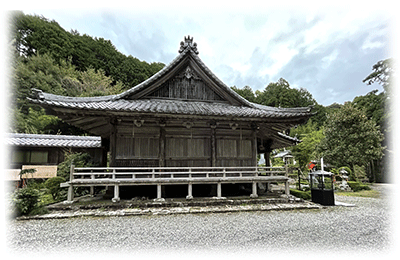
This temple is a Yakushi sacred place opened 1200 years ago by Saicho, the founder of Mt. Hiei. It started as the Tendai sect, but it has a strange history of being converted to the Rinzai sect after Kishu became the Tokugawa Gosanke during the Tokugawa period. The space that goes down the temple grounds and is covered with gravel is used as a camp facility. The charge is 3,000 yen with a power supply, and you can enter the bath by adding 200 yen. I also used a new and large bath where the scent of cypress hasn't come off yet, so I paid 3,200 yen.
The priest of the temple listened to my wish for a departure time of 6:30 the next morning. Then, just before the departure, I asked him to worship at two places, the main hall and the Yakushido. The reason was that it was a temple of the Rinzai sect. When I was a university student, I went to Kamakura Engakuji Temple, the head temple of the Rinzai sect, every December, and had the experience of participating in a week-long event called "Winter Student Sesshin" and meditation. For that reason, the sect of the family is the Jodo Shinshu Nishi Honganji sect, but I feel very close to the Rinzai sect as I can read the sutras of the Heart Sutra. When I told the temple priest about what I experienced when I was young 50 years ago, he was very amused.
Kouyasan
By the way, this trip, which I had traveled with almost no schedule, reached the final day, and I booked the Meimon Taiyo Ferry bound for Moji at 19:50 from Osaka Nanko. On the final day, I decided to go to Mt. Koya via "Toretore Market" in Nanki Shirahama, and then head to Osaka on my way home.
I arrived at Toretore Market in Nanki Shirahama about 100km from my accommodation in less than two hours.
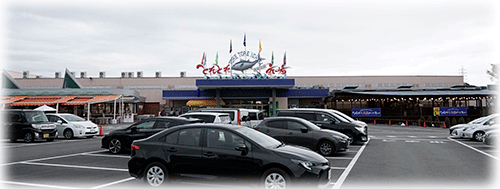
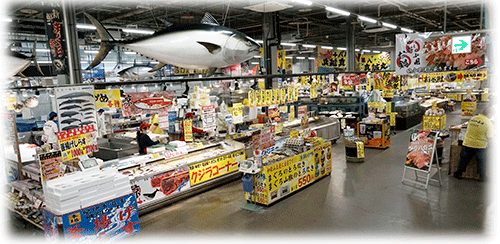
The outside and inside of the store looked like this. Finally, I found a spiny lobster.
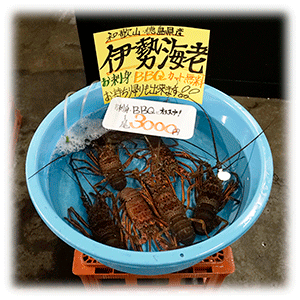
I should have been able to serve my purpose by purchasing this and having it cooked at the store. However, after all, the eating and drinking space where you can eat cooked food starts at 10 o'clock. Having to wait a little less than an hour until 10 o'clock is a waste of time, and I can't afford it on the way. In the end, I decided to give up on this as well and head for Mt. Koya.
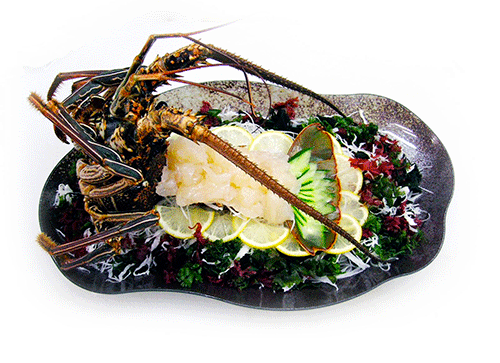
This lobster figure sashimi was created by the author in 2007. For the time being, I would like to tell the readers that I was drawing such an image.
The road to Mt. Koya was a series of steep mountain roads. I left Toretore Market at 9:30, but after traveling about 110km, I arrived at Mt. Koya in the basin between mountains at an altitude of 1,000m.
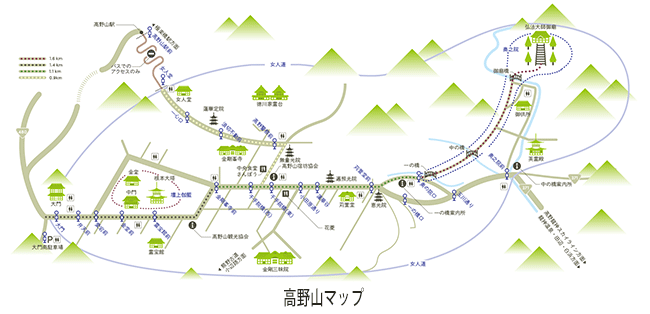

The upper Koyasan map refers to the homepage of the Wakayama Prefecture Tourism Association, and the lower figure is a map signboard image of the entrance to Oku-no-in. Koyasan is the entire area, and Koyasan itself does not exist. There are 117 temples here, making it a city. In addition to the temple, there is also a large graveyard called Okunoin on the vast site. There are tombs of the imperial family, Kuge, and daimyo, and it is said that there are 60% of the tombs of the Sengoku daimyo, and the number is said to exceed 200,000. There were also brand new large tombs, which were mostly memorial towers for large Japanese companies, and the fact that a memorial tower could be built on Mt. Koya was like a first-class proof.
Among them, the founder Kukai (Kobo Daishi) is in the highest position in Okunoin. This mausoleum is at the back, and there is no image because shooting is prohibited. As you know, Kobo Daishi is known as an unprecedented calligrapher, and it seems that he is like a god to those who practice calligraphy.
When that happens. From Nachi Kuroishi's inkstone to Kobo Daishi, this was like a fate, and I felt that this led to his wife's calligraphy promotion exam. Then, without hesitation, I decided to attach Kobo Daishi Ofuda as a talisman to the inkstone and purchased it.

The straight line distance from Okunoin to Kongobuji Temple is about 2 km, but since the narrow path is winding, it is actually about 3 km, and it was a distance that I thought I had finally reached Kongobuji Temple on foot.
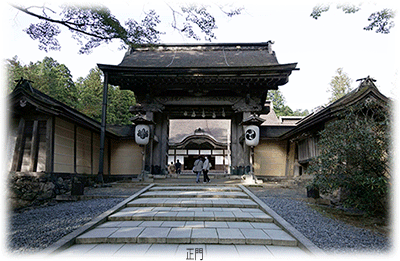
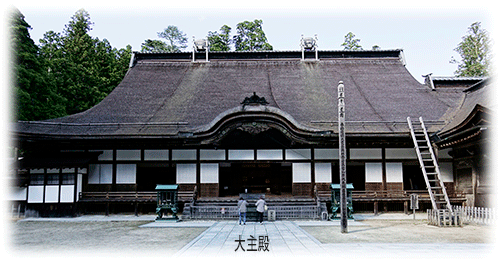
The two images above are the main gate of Kongobuji Temple and the main shrine. I have seen many temples on this trip, but I noticed that this Kongobuji temple is equipped with unusual facilities.

It is a facility located in a place where the noise in the above image is not added. At first I thought there was something that wasn't very elegant. However, when I looked it up later, I found that this was a facility called tensuioke. The roof of Kongobuji is not a roof tile, but a Hiwadabuki made of many cypress boards, and when a fire breaks out, the rainwater stored in this tub is used to prevent the sparks from flying and burning to the roof. It is a fire extinguishing facility that plays the role of soaking and getting wet and digesting. I also found that the ladder in the lower right was for climbing to the rainwater tank, and when I understood Tensuilke, I was able to understand the meaning of the ladder.

The main entrance of the main shrine in the above image is that only the emperor / royal family and Koyasan heavy duty entered and exited in the past. The main entrance had a wonderful presence, with carvings between Koryo, majestic futanoki, and Sankarado with Hishizama patterns.
Finally, it was past 15:00, so I decided to return to Osaka Nanko. Before that, there was a store that manufactures and sells Samue on the way to Kongobuji Temple, so I was thinking of buying Samue as a souvenir for myself. When I entered the store, a person like the owner's wife showed me various things, but I noticed that there was only one 10,000 yen bill in the coin purse.However, she showed me only items that cost more than 10,000 yen. If you don't have the money, it was Koyasan High School's training clothes that gave me this feeling. However, this was also over 10,000 yen. Until then, I always carried my backpack on my back and put a wallet in it, but only on this day I left my backpack in the camper. For this reason, I couldn't buy Samue after all, and I couldn't get anything to commemorate this trip.
After that, I made the navigation system input Osaka Nanko and departed. The plan was to arrive at Osaka Nanko within two hours via Izumisano City, Kishiwada City, and Sakai City on the Hanwa Expressway. However, on the way, I was invited to a navigation system on a mountain road that I thought was strange. I believed in navigation for a while, but the place where I got off the mountain road was Gojo City, Nara Prefecture. Then, Navi entered the Hanna Road and headed for Higashi-Osaka City, and took a route that blended into Chuo-ku, Osaka City.
Originally it should arrive at 17:30 at the latest, but it was getting late. I was also caught in a traffic jam and was worried that I might not arrive by 19:00, which is recommended to arrive at the ferry terminal. After all, I arrived at around 18:45, which took more than an hour and a half.
The Hilux Tru-cam is longer than usual, wider, and of course heavier. The air suspension added for Tru-cam supports the heavy weight so that it does not fall down. However, while it is fluffy and comfortable to ride, it moves up and down, sways left and right, and is unstable. That's why I have to be very careful on sharp curves and be careful of bumps and bumps on the road, which is many times more nerve-wracking than a normal passenger car. I'm really tired if I continue driving with such care many times for more than 3 hours without a break, feeling that I can't make it in time unless I hurry. When I arrived at Osaka Nanko safely, I was really relieved.
The end of the trip
The mileage of the electric bicycle Panasonic Hurryer, which was active on this trip, was about 90 km. In Nara, I traveled 40km a day, but only on this day, the charge was 90% in the morning, so I was worried about whether the battery would last until the end. However, the mobility of the Hurryer's powerful assistance helped me a lot, and I was less physically tired.
In addition, my car Hilux ran 1,048 km in 8 days, but it was not a burdensome distance for a car trip and it was easy. The cumulative mileage of this Hilux was 80,000 km on the last day of this trip, but I think that the mileage is overwhelmingly short for the 1998 model year. This car is completely trouble-free and looks shiny because the internal equipment and the outer circumference are carefully modified and maintained every year. This Hilux is already over 20 years old, but I think it helps to show how robust and excellent this model is.
By the way, how many readers read this month's issue, which has become a really long article, to the last line? I never expected it to be this long, and I am surprised and regretted that it has become so long.
This year, the calculation was wrong from the stage of planning the trip, and the article summarizing the trip also went crazy. I'm sorry to all of you, I've barely touched on fish in this month's issue. Since the outlook was unsatisfactory from the stage of planning the trip, miscalculations occurred frequently. Please forgive me for this point.
But to tell the truth, the journey is interesting because you don't know what it is, and the mistakes you make in the journey are forever memorable. For myself, I have the feeling that "Oh, this trip was also interesting ...". I'd like to write about fish in the next month's issue, so don't be afraid of this month's issue, and I definitely want you to visit next month.
| Please access the following URL if you want to secure using SSL. All pages in the site will be secure pages. |
https://secure02.blue.shared-server.net/www.fish-food.co.jp/message english 11.2021.html |
An opinion and the communication are to iinfo@fish food times
Date of updating 1 Nov. 2021
